Trafalgar Square sits at the heart of London and is one of the city’s most important landmarks. Here’s what you need to know before you go.
Trafalgar Square is a London icon. Plumped in the centre of the city – there’s a reason that it’s at the top of every tourist’s sightseeing itinerary.
But how much do you know about Trafalgar Square? Sure, it’s home to Nelson’s Column, lots of statues and, of course, the National Gallery. But beyond that? Let’s explore.
Must-See Spots on Trafalgar Square
Nelson’s Column
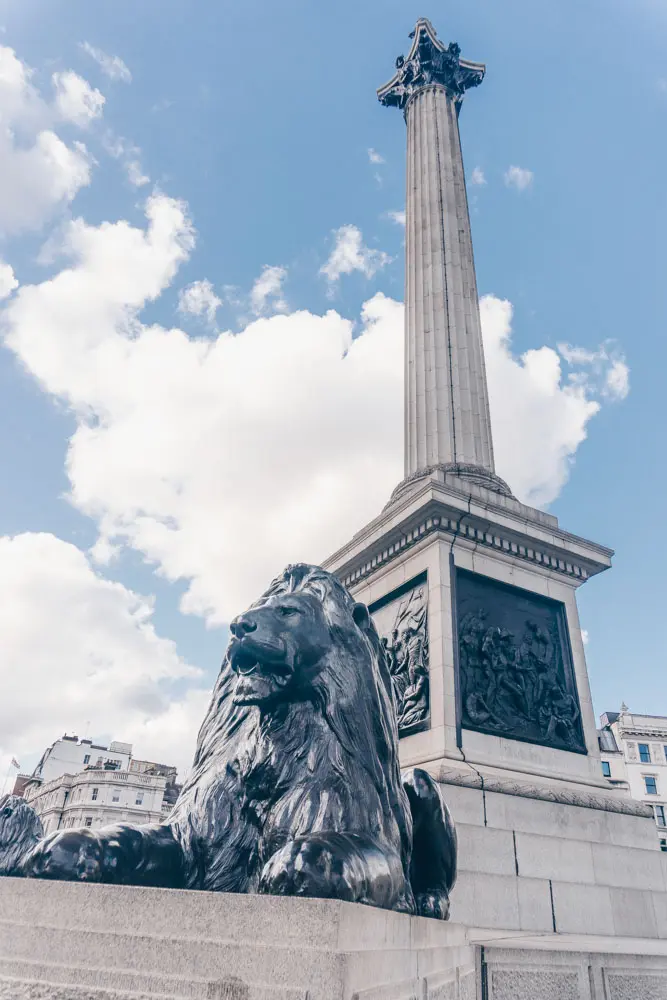
Trafalgar Square itself is named after the Battle of Trafalgar. Famously, this naval battle between Britain and the Napoleon-led France and Spain would claim the life of Admiral Nelson, but become his most famous victory.
So it made perfect sense to erect Nelson’s Column in the square named after his most famous battle.
The column was commissioned to be designed by four of the top sculptors at the time. The design itself, however, was chosen from a design contest. The competition was not without controversy, but eventually the design of William Railton was chosen.
At over 169 feet (51 metres), it’s dizzyingly tall – although not quite as tall as the original plans which stood ten metres higher.
Over the years, Nelson’s Column has remained Trafalgar Square’s most famous sight. It’s also been the subject of plenty of stunts – from being turned into a lightsaber to celebrate the release of the a Star Wars film, to numerous political statements.
The National Gallery
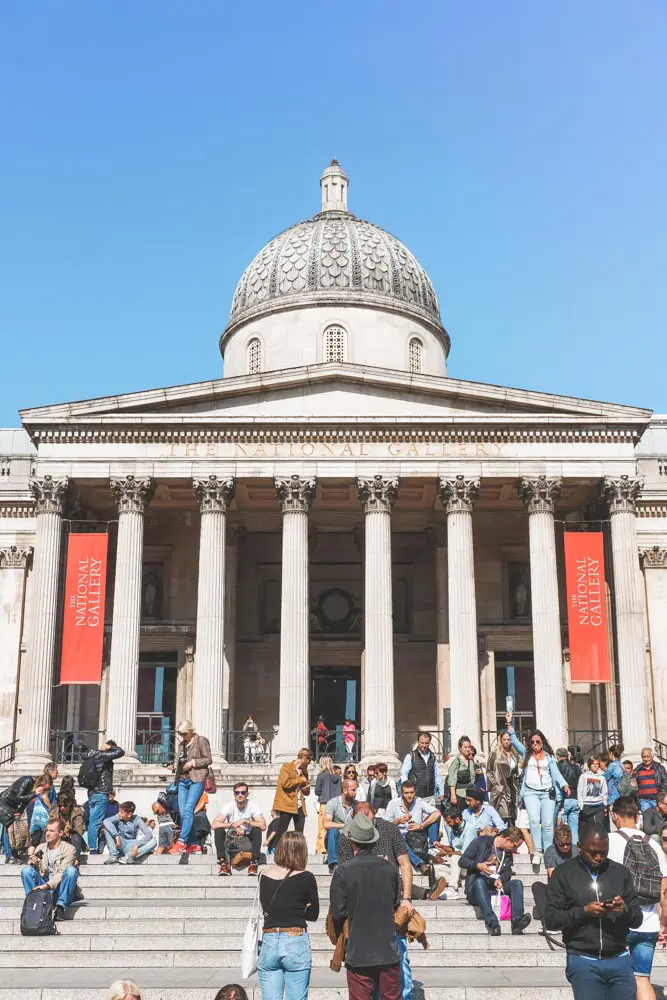
You will find over 2,300 paintings inside the building, with works spanning the period from the mid-13th century straight through to 1900.
The scope of the collection is impressive – famous works include Vincent Van Gogh’s Sunflowers and Leonardo da Vinci’s The Virgin of the Rocks.
You can check out the other exhibitions running at The National Gallery here.
Read More: Free Museums in London
Trafalgar Square Lions
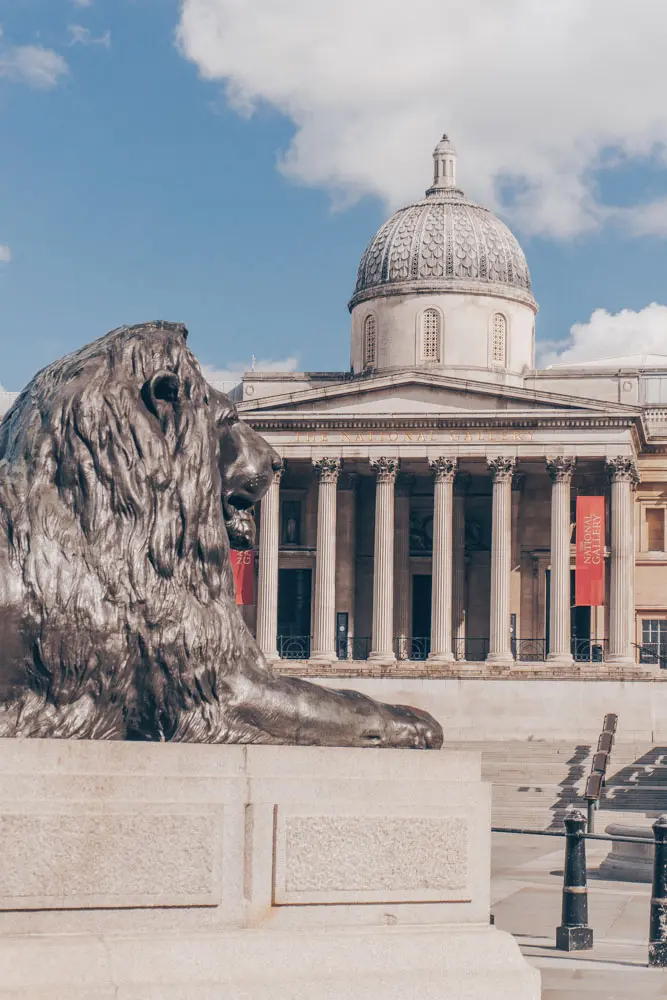
All very well and good, but there’s more to the lions than meets the eye.
The lions were sculpted by Edwin Landseer – who until he accepted the commission had never sculpted a thing in his life (no pressure then). He’d been given the project after the first lions by the original sculptor, Thomas Milnes, had been rejected.
It took Landseer ten years to craft the massive lions. He carefully studied lions in the zoo, as he had mostly painted dogs and horses during his career – he even had a dead lion sent to his studios so he could get a true to life portrayal.
Unfortunately, things didn’t go quite as planned – the lion started to decompose before he’d finished the sculptures and he had to do a bit of improvisation. Guess that explains why they have a slightly odd look about them.
Luckily, they didn’t come under too much fire when they were finally revealed in 1867 and they have flanked the column ever since.
The Fountains
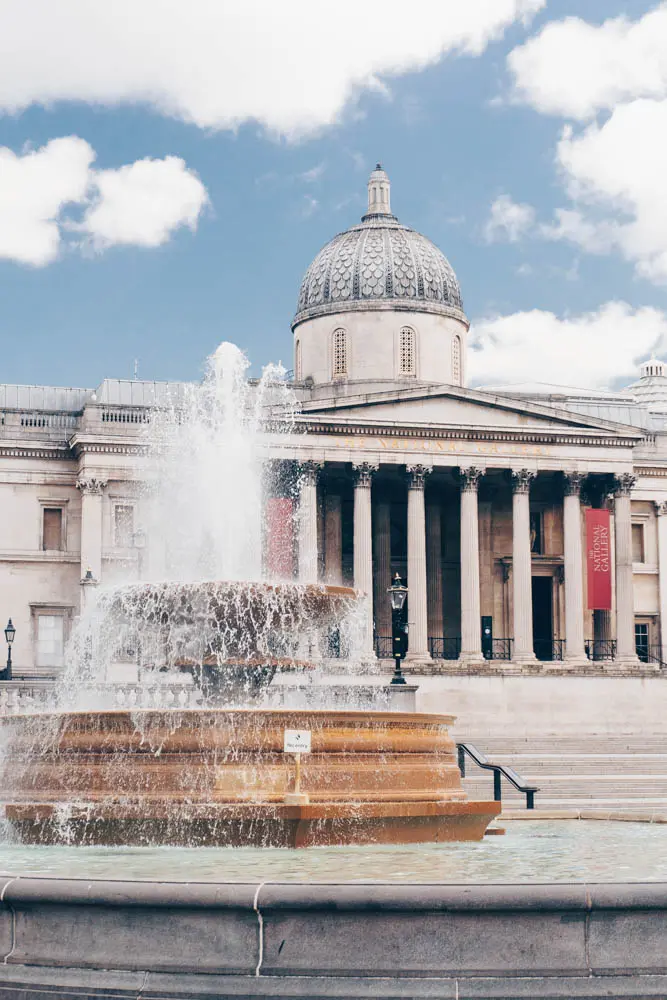
The plan was also popular with the Government, who saw it as a way to decrease the likelihood of any pesky riots.
As such, two new fountains were designed and added to the square in 1841. The design, however, was pretty bland.
It wasn’t until the 1930s that it was decided it was time to jazz them up a little – Sir Edwin Lutyens took on the commission and got to work.
As such, new features including whimsical mermaids frolicking in the fountain were added, creating the fountains we know and love today.
The Trafalgar Square Statues
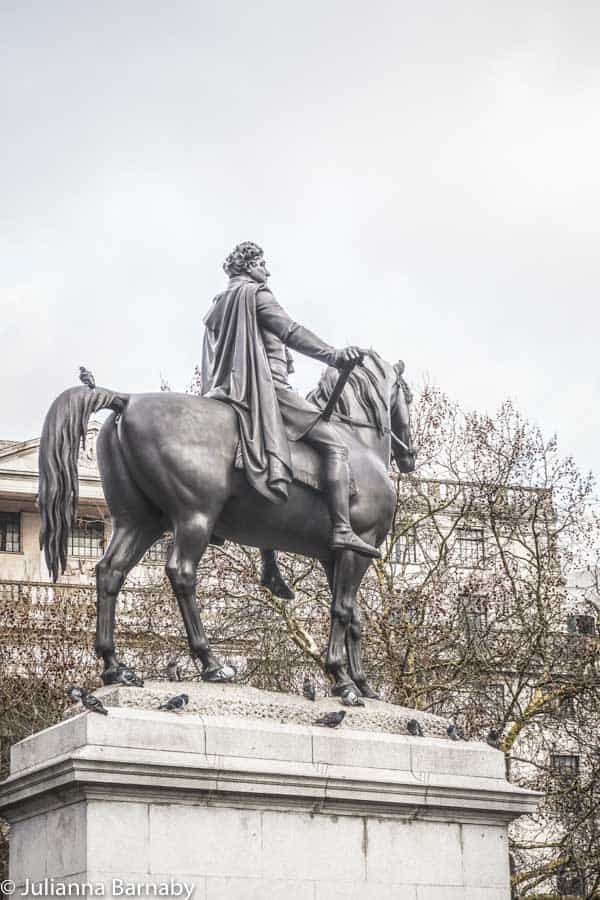
Around the square, there are four plinths for sculptures. Three of them have permanent “residents” – General Sir Charles James Napier, Major General Sir Henry Havelock and King George IV while the fourth hosts an ever-changing rotation of contemporary sculptures.
Napier was a veteran of the Peninsular War in Iberia against Napoleon Bonaparte in 1812 before going on to become Major General of the British Indian Army at the age of 60 in 1842. The statue was erected in 1855, two years after his death.
Meanwhile, Haveolck was a British General whose most famous intervention occured during the Indian Rebellion of 1857 during which he listed the siege of Lucknow, where he died days later of dysentery.
Perhaps more oddly, there’s also a statue of George Washington on Trafalgar Square, which, considering he was considered a traitor by his contemporaries, is quite something
It was a gift to the city of London from the state of Virginia in the USA, which is why today you will find him confidently perched outside of the National Gallery.
The Fourth Plinth
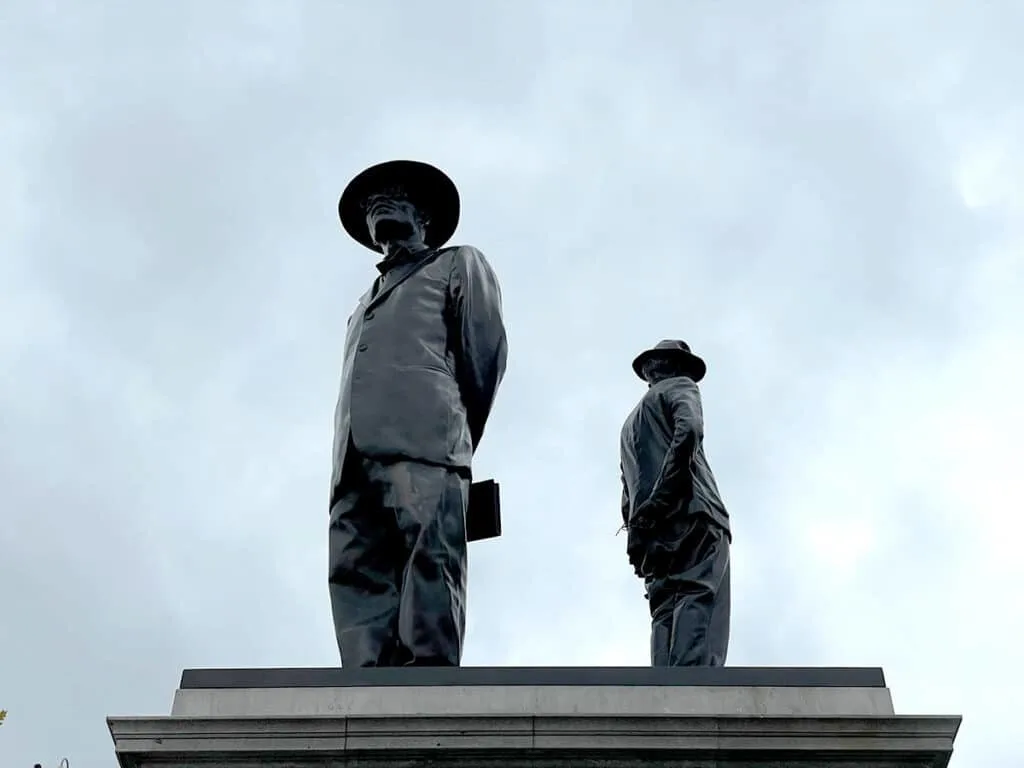
The three plinths are kind of interesting in that “oh, here’s a sculpture of a guy from the past” kind of way, but it’s really at the fourth plinth where things start to get interesting.
The fourth plinth sits on the northwestern edge of Trafalgar Square. Originally, it was supposed to be the site of a statue of King William IV. Fittingly for a project depicting a man with his own fair share of money woes, financial troubles put the kibosh on the project.
The plinth remained empty for more than 150 years. But in 1998, a solution was found. The plinth would serve as a showpiece for a changing display of contemporary art.
Since then, the Fourth Plinth Commission has been in charge of commissioning the fourth plinth’s artworks. At the time of writing the plinth has seen 14th commission recently stand upon the fourth plinth, Antelope by African sculptor Samson Kambalu that restages a photo of Baptist preacher John Chilembwe and European missionary John Chorley.
Other famous pieces on the fourth plinth over the past 25 years include sculptures of disabled artists Alison Lapper, One & Other by Antony Gormley, the Gift Horse by Hans Haacke and, appropriately, Yinka Shonibare’s depiction of HMS Victory in a bottle.
The World’s Smallest Police Station?
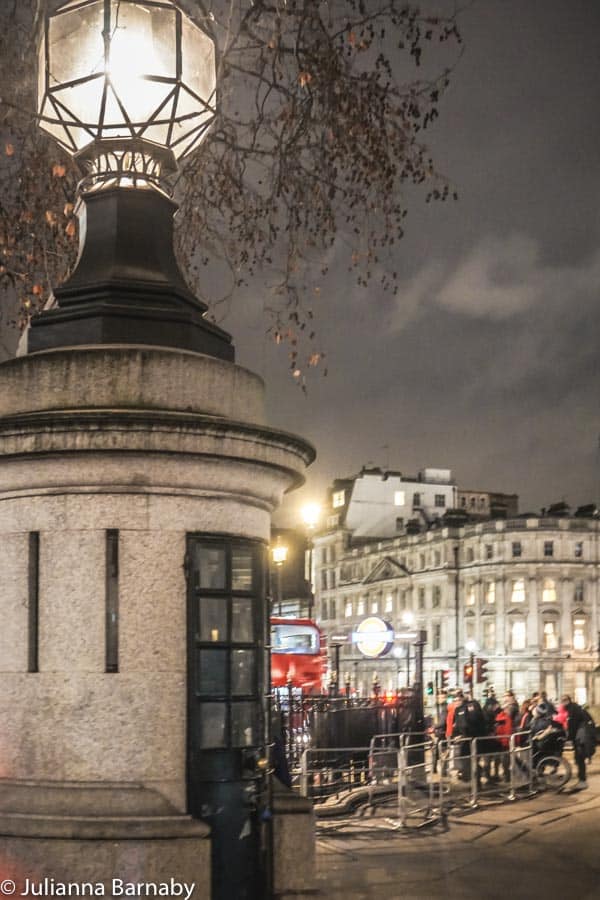
Then I heard rumours that it was the world’s smallest police station, so I decided to look a little closer.
Located on the southeastern corner of Trafalgar Square, it is about the size of a phone box, although it’s not the distinctive red in colour. You’ll know you’ve spotted it when you see the heavy door.
The micro-station was built in 1926 so that the Met police could keep a watchful eye on demonstrators who had begun to take to Trafalgar Square. It was originally a temporary thing, but they soon decided to make this station more permanent and installed lighting inside.
The narrow windows all around the building were meant to give panoramic views of any unlawful activity in the area and the light on top would flash, alerting nearby officers that back up was very much needed.
It’s hard to believe looking at its pokey size, but it was in use for over a century. Not only does the building offer a great view out of Trafalgar Square, but it was also big enough to house a police officer and a wretched crook!
Alas, before you go telling your friends you’ve seen the world’s smallest police station… it actually isn’t. Technically it was a lookout post, not a police station (those are officially designated) – but why let a technicality spoil your fun?
The Official Measures
Let’s be honest, the imperial system of measurement can seem quite baffling.
None of this centimetres and metres business, the imperial system relies on measurements including inches, links and feet.
When the system was devised, a set of ‘standard measurements’ were safely locked away as the one true record of how long each of these measurements was.
Unfortunately, the team learnt the lesson of “always have a back-up” the hard way when the standard measurements were destroyed by a fire at Winchester Palace. In their place, they made three new sets of measurements (which they hope match the originals).
One of those sets is now found at the bottom of Nelson’s Column. If you look closely, you’ll see the plaques noting different distances. It’s a pretty cool piece of London history right there.
St Martin in the Fields
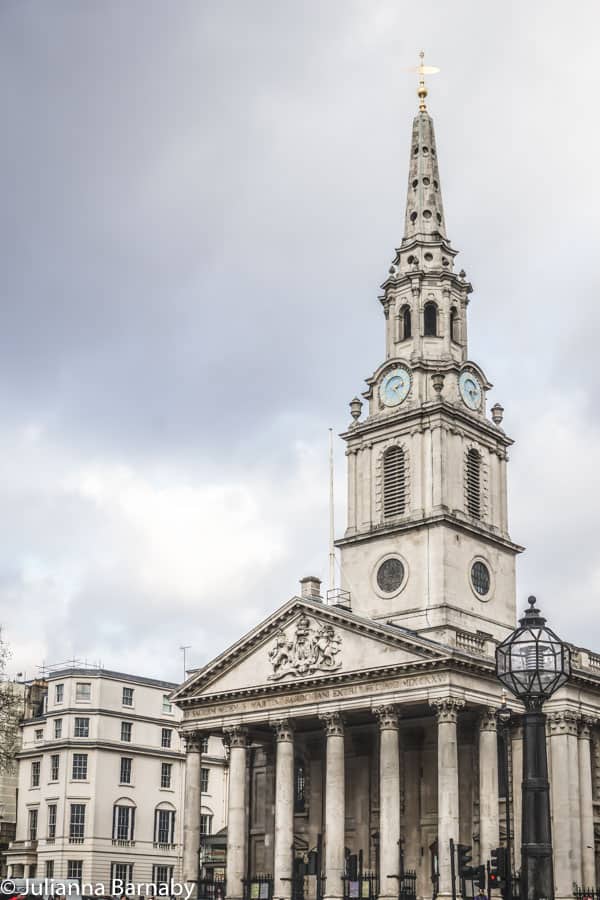
A church of some description has stood on the site since at least the 1200s, when there’s a record of a dispute that was mediated by the Bishop of Canterbury in 1222. However, the current Neoclassical building dates from the early 18th century.
In fact, the history of the site can be traced back even further than the squabbling churches of the 1200s.
While excavating the site, a Roman grave from around 410 AD was found, and lends some evidence to support the idea that the site’s spiritual history extends even further than first thought.
Whenever it began, today it is a beautiful church that is a must visit for those who love beautiful architecture. The building is Grade I listed, and inspired many American churches.
Another claim to fame for St Martin’s in the Field is that it was even mentioned in George Orwell’s Nineteen Eighty Four.
As well as the Church itself, there’s also a cafe and a gift shop. They even hold frequent(ish) jazz concerts and free lunchtime concerts that are always well worth popping into!
Many of the funds raised by the church’s events go to supporting homeless people in the area.
Read Next: Fabulous Places to Visit in London that are Completely Free
Canada House
Sitting on the Western side of Trafalgar Square, Canada House is unmistakable thanks to its show of red and white Canadian Flags outside.
Designed in the Greek Revival style of stone from Bath by Robert Smirke, the same architect behind the British Museum, Canada House has served as the offices of the High Commission of Canada since 1925.
Originally two buildings originally used to house the Union Club and the Royal College of Physicians, they exchanged hands for £223,000 in 1923 when the Canadian High Commissioner acquired the Union Club to centralise the work of 200 workers scattered across London.
The interior is largely off limits to the general public, although they do offer regular tours at scheduled times. However, the Canada Gallery, which showcases the best Canadian art and craft, is open to the public.
The Trafalgar Square Christmas Tree
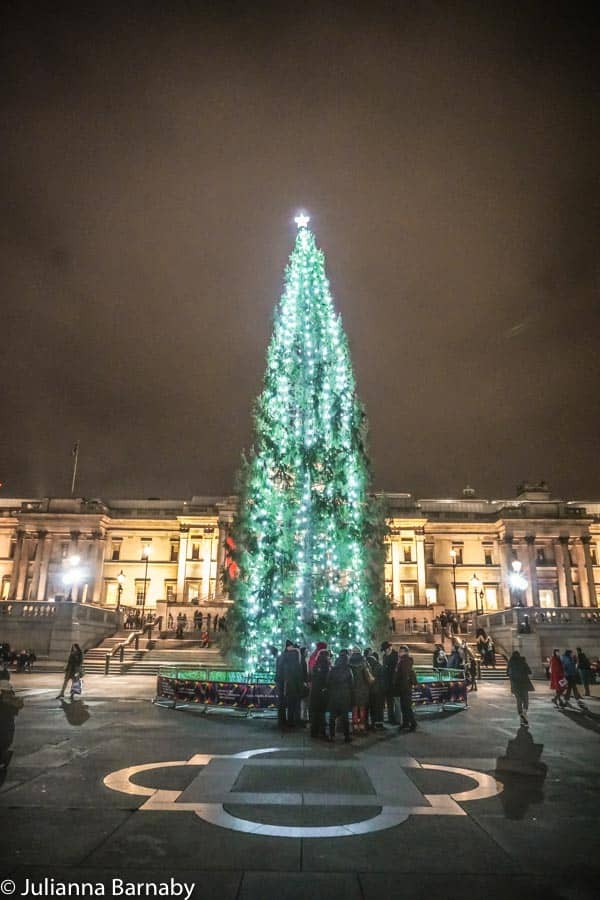
It’s not just that the tree is beautiful – although it is – but also the backstory. Every year since 1947, the Norwegian Spruce tree has been donated by the City of Oslo in Norway as a sign of the country’s appreciation for Britain’s support during World War II.
Ah, friendship across the North Sea.
In late November each year, the tree is cut in Norway and then sent via boat to the English capital. Once it arrives, it is decorated, Norwegian-style, before it is revealed to the public in all its glory in early December. It remains on show until around 6 January.
As well as serving as a token of cross-country friendship, the tree is also the site of many beautiful carol performances. Most funds raised by these performances go to supporting various charitable works. It’s just feel-good all round, really.
Read More: The Best Things to do in London at Christmas and in Winter
Grab a Cocktail at the Rooftop of The Trafalgar St James
You know us, we love a rooftop bar and one of our faves is The Rooftop at The Trafalgar St James.
This cool cocktail spot has everything you could want on its extensive menu, yet with incredible skyline views across Trafalgar Square towards the City with St Pauls, and its array of awesome modern architecture.
Enjoy a lazy weekend brunch, a long lunch, or romantic evening meal with drinks as the sun sets over the city. Their specialty Belvedere Martini is unlike anything we’ve sampled before, while expert cocktail makers will come and make these blowaway martinis at your table.
The summer salads are great, but if you’re seeking a winter warmer, grab their oozy cheese fondue to emphatically hit the spot!
History of Trafalgar Square
It would be easy to start the history of Trafalgar Square with the Battle of Trafalgar – however that would be to miss out some of the most interesting history of the square.
In fact, the history of Trafalgar Square reads much like an exhibit from the British National Museum. In the 1950s, building works revealed the skeletons of a number of great beasts under the square, including cave lions, rhinos and hippos.
It might seem hard to imagine the famous London square being stomped on by the hooves of giant mammals, but that was the case several millennia ago.
A little more recently, the area near the church of St Martin’s in the Field was used as a burial ground for the Romans. Although Trafalgar Square itself was beyond the walls of Roman London, it is thought that the area was still very much in use.
King’s Mews
The area really began to grow in significance in the 13th Century, when the area was used for the “King’s Mews” – the King’s stables used to house the carriages and horses of the nearby Whitehall Palace and, curiously, the royal hawks too.
The King’s hawks enjoyed some pretty pricey real estate back in the day.
The Creation of Trafalgar Square
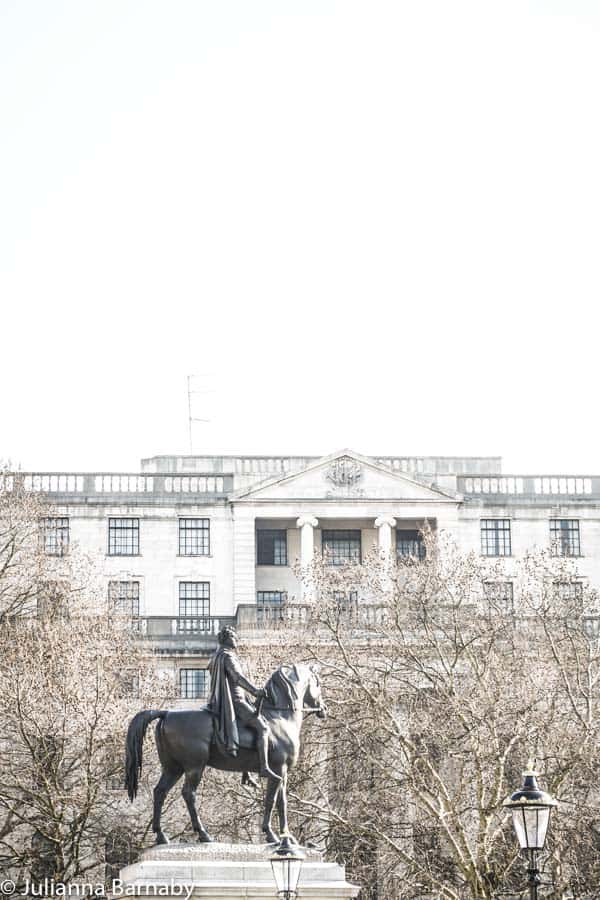
In around 1826, the idea for a large public square began to take shape. Plans were drawn up, and arguments were had over the name for the square.
Eventually, it was decided that the square would be named after the Battle of Trafalgar, an epic naval battle where the British, under the command of Lord Nelson, defeated the French and the Spanish in the Napoleonic Wars.
Good for Britain, but not so great for Lord Nelson – he was shot and killed aboard HMS Victory.
After this, his body was displayed in what is now The Painted Hall for visitors far and wide to marvel at until January 1806, before he was finally laid to rest in St Paul’s Cathedral.
Despite this – or maybe because of it – he has gone down as an almost mythical war hero. The most dramatic statue on Trafalgar Square is devoted to him: Nelson’s Column.
Trafalgar Square Today
Over the years, Trafalgar Square has become the epicentre of many protests, a kind of living art gallery, and above all, a space for visitors and Londoners to enjoy.
So significant is Nelson’s Column for London, that during World War II the Nazis had planned to capture it and bring it back to Berlin. Luckily, they did not succeed, and it continues to be one of the most enduring symbols of London.
Handy Tips for Visiting the Square
- A great time to visit Trafalgar Square is during a sporting match. You’ve never seen Londoners get more rowdy! There’s usually a big screen set up and the atmosphere is fabulous – especially if we’re winning (which is less often than we’d like).
- Trafalgar Square is well located for exploring central London. From here, you can easily reach the attractions of Covent Garden, mouthwatering restaurants of Chinatown, and then catch a show at the West End.
- Trafalgar Square is popular with street artists and buskers. You might want to fill your pockets up with some coins to flick to any you find particularly inspiring. Some are truly dreadful though.
- The square is one of the most visited tourist attractions in London. We think taking in the buzzing atmosphere is part of the fun, but if you prefer things a little more subdued, aim to go early in the morning before the other tourists arrive.

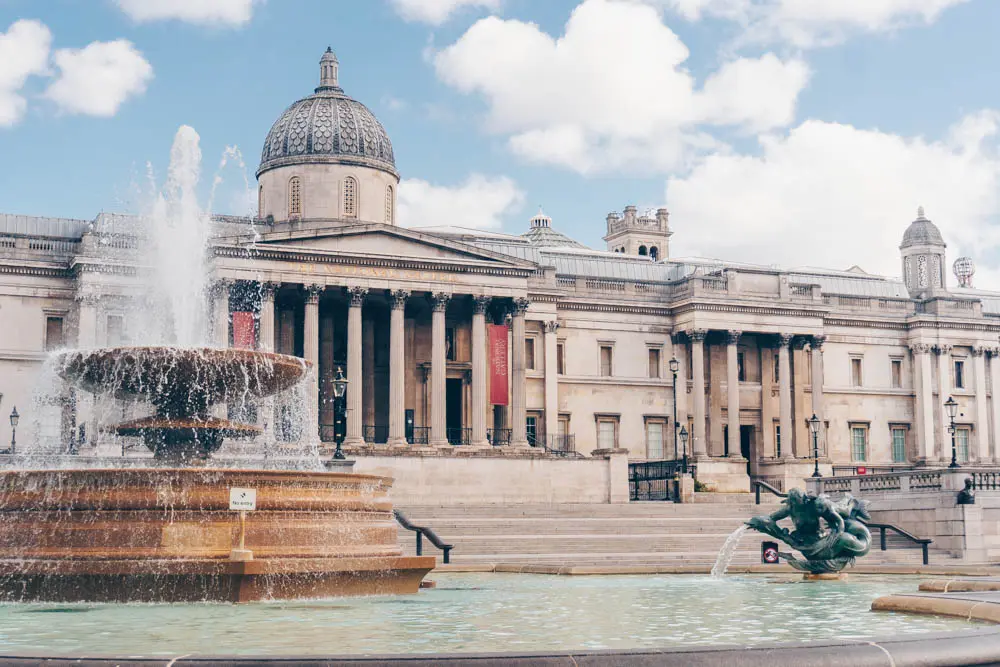
Shunda
Wednesday 17th of June 2020
Your post is what made me want to visit Trafalgar Square. And I did, it was great. Before this my family and I took in the scenery took pictures in front of the statues and the fountains. It was so a fair amount of people there. Walking up the steps and taking in the views was picturesque. Thanks for the recommendation.
Julianna Barnaby
Friday 19th of June 2020
Cheers Shunda - I'm so glad that you got to visit before this current craziness. An absolute pleasure and I hope you're having fun exploring.